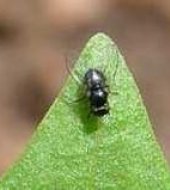
Bean flies (Ophiomyia spp.)
Bean flies also called bean stem maggots are serious pests in Africa. The adult is a tiny (about 2mm long) fly, shiny black-bluish in colour. The female fly pierces the young leaves to lay eggs and sucks the exuding sap. This leaves yellow blotches on the leaves, which are the first signs of bean fly attack and may serve as early symptom useful for monitoring the presence of this pest in the field. Maggots mine their way from the leaves down to the base of the stem, where they complete their development.
Maggot feeding destroys the tissue causing the stem to swell and split and reducing formation of lateral roots. Attacked plants produce adventitious roots in compensation. Maggots (yellow in colour) and pupae (brown or black in colour) can often be seen through the stem splits. Young seedlings and plants under stress wilt and die when attacked by bean flies. Older or vigorous plants may tolerate bean fly attack, but their growth will be stunted and their yield reduced. Damage is more severe in plants growing under poor conditions such as infertile soils and drought.
- Plant early in the season. Bean fly numbers tend to be low during the early stages of the growing season and increase with time.
- Provide favourable growing conditions to improve plant vigour and to enhance tolerance to insect attack and damage. For instance, soil fertility can be improved by adding organic fertilisers and well decomposed farmyard manure.
- Mulch (e.g. with straw and cut grasses) helps conserve moisture, promote adventitious root development and enhances tolerance to maggot damage.
- Avoid planting beans near cowpea, soybean and many other leguminous crops, that may be the source of bean flies.
- Remove and destroy crop residues and all plant parts with symptoms of damage by bean flies.
- Earth up (building up) the soil around the plants to cover the roots at 2-3 weeks after emergence helps the adventitious roots to grow more quickly. If there is enough moisture, the plants are able to recover from the damage.
- Use botanical insecticides such as neem. It has been shown that frequent foliar application with neem extract gives satisfactory control of this pest.
- Use resistant varieties: Several lines of dry beans have been identified as having good levels of resistance to bean flies in East Africa. These lines are available form the CIAT Regional Programme and from national agricultural research programmes in the region.
